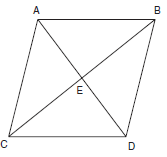Determine if each statement is true if
(i) ABCD is a parallelogram
(ii) ABCD is a rhombus
In each case, if true, explain why.

(a) AD ? CB
(b) ?AEC ? ?BED
(c) ?AEC ? ?AEB
(d) ?CEA ? ?BEA
(a) True for rhombi, but not for non-rhombi parallelograms. Diagonals are perpendicular in a rhombus.
(b) True for both parallelograms and rhombi; vertical angles.
(c) False (supplementary, not congruent)
(d) True for rhombi, but not for non-rhombi parallelograms. Diagonals bisect the opposite angles in a rhombus.
You might also like to view...
State how many peaks you would expect for the distribution described.Number showing when a single die is rolled 100 times
A. None B. Three C. Two D. One
Change 0.05% to a decimal equivalent.
A. 0.05 B. 0.0005 C. 0.005 D. 0.5
Solve.There are 40 students in Jose's class.  of the students are science majors. How many students are science majors?
of the students are science majors. How many students are science majors?
A. 30 students B. 10 students C. 8 students D. 40 students
Find the first and second derivatives of the function.
?

A. ?
B. ?
C. ?
D. ?
E. ?




